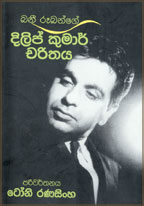|
Dilip Kumar's biography in Sinhala Biography: The well-known thespian Tony Ranasinghe has proved beyond doubt that he is much more than a mere performer on the stage as well as on the screen for at least four decades. He has from time to time taken time off from his duties as an actor for writing film scripts and translated and directed some of Shakespearean plays and written his own creative pieces; if I remember correct, a Sinhala novel.
The latest addition to his printed works is a translation of a biography of Dilip Kumar, the well-known versatile Indian actor, who created an image for himself not only in the Asian show business but also in various countries abroad through his vibrant albeit sensitive performance, this translation according to the published text has been written by a veteran Indian communicator named Bunny Reuban, who had gained sufficient experience in the field of cine journalism extant from the early stages of the 1940s contributions to such Indian film journals as Filmfare, Star and Style, and Cine Blitz. Though I have not had the opportunity to read the original work [Dilip Kumar star legend of Indian cinema the definitive biography), I felt it is one of the well researched biographies which eventually help build a better understanding of the task in the life of a dedicated artiste in the field of cinematography from its very inception. As things in our country spin up with reference to the evolution of the local cinema is concerned the industry suffers on account of persons involved devoid of an ideology of the developmental nature wanted for the moulding up of a better climate and observed to be seen as having a mere threshold interest. ExperiencesThe dedication as shown in this book where Dilip Kumar is visualised as a person who has undergone the entire gamut of experiences needed to be a mature intellectual with his discrimination and challenges encountered from 1944, had led to glorious exemplary future written more with actual events from his life in the form of an investigative narrative and a series of interviews interspersed with those who knew him closely and those who were critical of his talents inclusive of such persons as film critics, directors, producers, fellow actors, actresses, and relatives and well wishers. The views expressed by the author Reuban is well presented in Sinhala enabling the reader to grip into the work more closely forgetting the fact that he is browsing through a mere conventional biography with dates and figures. There is no moment of dullness in the _expression of the life and challenges encountered by Dilip Kumar [born on 11 December, 1922] as the translator Tony Ranasinghe has gripped his cause with a sense of sensitive dedication closer to his heart, knowing all the nuances of the film industry in the manner of a film aesthete. While retaining the basic and essential ingredients that go into the making of a biography, the work too embraces such areas as the aspects of the evolution of the film industry, the functions of pioneers in the field, the personal glimpses and fantasies such as friendships, animosities, learning, earnings, affiliations involved in romances, marriages and break-ups of the same etc, presumably part and parcel of the industry. One of the finest areas embedded is the protagonist Dilip Kumar in his venture to be an actor yearns to be a singer and an instrumentalist with great difficulty as it is seen as a talent acquisition for a particular purpose. Mention is also made on the unavoidable links the protagonist Dilip had with his contemporaries like Raj Kapoor, Dev Anand, Guru Datt, Mehboob and female stars like Nargis, Madhubala and Vaijayantimala. The sensitivity in which these areas are covered make us feel that the world of cinema had not been a bed of roses for Dilip. Then the biographer too makes it a point to underline the gratitude and remembrances in a humanistic standpoint as regards his gurus in the film world, especially the maker of his first film Amiya Chakravarti. Some salient aesthetic cum critical factors like discriminative selectivity on the part of a film actor trying his best to keep the good will without misgivings is shown as a dominant achievement in Dilip Kumar's career. Visual impactHe is shown as a person who had gradually cultivated the habit of being vigilant as regards the roles he played and a unique example is cited from real life as to the moment of the event of his being selected to play the role in the film titled Insaniyat [which was also dubbed into Sinhala as Manushatvaya] Dilip Kumar is said to have had a narrow escape from torture from an enemy who was later found as a mental patient who had misunderstood his mission from a racial point of view. Most of the films referred to in this biography have been shown in our country in the fifties and early sixties, and as such the visual impact, creative process, melodious Hindi music output and the story lines embedded in each of those seems graspable in nostalgia. A few examples are Deedar, Ganga Jamuna, Mother India, Madhumati, Urankatola, Babul and Andas. I hark back to my personal entertainment of seeing many of these at the local cinema hall 'Capitol', Armour Street. One may recall how very haunting some of the songs and melodies were. A special reference is made on the film Andas as it had been the most significant film work which brought Dilip Kumar to the limelight [p117]. The biographer in an uninhibited tone shows us how the young actor Dilip had faced severe blows from his fellow workers trying to achieve perfection as his goal as an actor while some others were breathless and profuse in their output. Some other landmarks in the career of Dilip are the films like Devdas by Bimal Roy and Nayador by Chopra [p121]. However, when asked to explain his stance as regards his peformance, Dilip had been rather drawn back from commenting as he was aiming high and not quite satisfied with his respective performances. In this manner the reader feels that Dilip the actor had been a constant practitioner of his art and at several moments he had tried his best to grasp the essence of Stanislavskian techniques of acting [p100] at a time when it was quite unknown to the Bollywood circles. This reference is made to Dilip who had tried all his efforts to grasp the techniques from 1940 to 1950 as intensive physical and mental exercises necessary for the profession. Further reference is made to the manner in which he had tried to derive inspiration and influence from the acting styles of such well known actors as Marlan Brando and Montgomary Cliff [p95-96]. This is indicative of his sparkling unquenched thirst to learn. It is also interesting to see how a person bearing a name like Usuf Khan [Dilip's family name] becoming a Dilip Kumar as selected by himself out of three names suited for the career on the request of a pioneer film maker Devika Rani [p39] without whom things would have taken another trend in his way. All in all, I found the biography quite readable and resourceful. Readable as it is more narrative oriented and resourceful as it throws much light on to the hidden areas of our own affiliated cine culture. This biography in translation is indeed an excellent addition to the repertoire of film studies in our country. |
|
.................................. |





